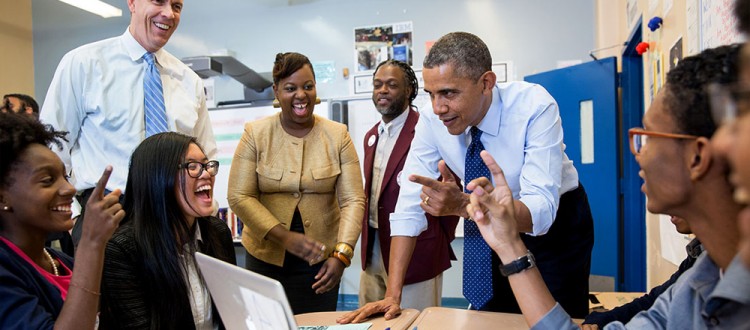Science, Technology, Engineering and Math: Education for Global Leadership
— President Barack Obama, March 23, 2015
The United States has developed as a global leader, in large part, through the genius and hard work of its scientists, engineers, and innovators. In a world that’s becoming increasingly complex, where success is driven not only by what you know, but by what you can do with what you know, it’s more important than ever for our youth to be equipped with the knowledge and skills to solve tough problems, gather and evaluate evidence, and make sense of information. These are the types of skills that students learn by studying science, technology, engineering, and math—subjects collectively known as STEM.
Yet today, few American students pursue expertise in STEM fields—and we have an inadequate pipeline of teachers skilled in those subjects. That’s why President Obama has set a priority of increasing the number of students and teachers who are proficient in these vital fields.

The need
All young people should be prepared to think deeply and to think well so that they have the chance to become the innovators, educators, researchers, and leaders who can solve the most pressing challenges facing our nation and our world, both today and tomorrow. But, right now, not enough of our youth have access to quality STEM learning opportunities and too few students see these disciplines as springboards for their careers.
The goals
President Obama has articulated a clear priority for STEM education: within a decade, American students must “move from the middle to the top of the pack in science and math.” The Obama Administration also is working toward the goal of fairness between places, where an equitable distribution of quality STEM learning opportunities and talented teachers can ensure that all students have the chance to study and be inspired by science, technology, engineering, and math—and have the chance to reach their full potential.
The plan
The Committee on STEM Education (CoSTEM), comprised of 13 agencies—including all of the mission-science agencies and the Department of Education—are facilitating a cohesive national strategy, with new and repurposed funds, to increase the impact of federal investments in five areas: 1.) improving STEM instruction in preschool through 12th grade; 2.) increasing and sustaining public and youth engagement with STEM; 3.) improving the STEM experience for undergraduate students; 4.) better serving groups historically underrepresented in STEM fields; and 5.) designing graduate education for tomorrow’s STEM workforce.
Supporting Teachers and Students in STEM
At the Department of Education, we share the President’s commitment to supporting and improving STEM education. Ensuring that all students have access to high-quality learning opportunities in STEM subjects is a priority, demonstrated by the fact that dozens of federal programs have made teaching and learning in science, technology, engineering, and math a critical component of competitiveness for grant funding. Just this year, for the very first time, the Department announced that its Ready-to-Learn Television grant competition would include a priority to promote the development of television and digital media focused on science.
The Department’s Race to the Top-District program supports educators in providing students with more personalized learning—in which the pace of and approach to instruction are uniquely tailored to meet students’ individual needs and interests—often supported by innovative technologies. STEM teachers across the country also are receiving resources, support, training, and development through programs likeInvesting in Innovation (i3), the Teacher Incentive Fund, the Math and Science Partnerships program,Teachers for a Competitive Tomorrow, and the Teacher Quality Partnerships program.
Because we know that learning happens everywhere—both inside and outside of formal school settings—the Department’s 21st Century Community Learning Centers program is collaborating with NASA, theNational Park Service, and the Institute of Museum and Library Services to bring high-quality STEM content and experiences to students from low-income, high-need schools. This initiative has made a commitment to Native-American students, providing about 350 young people at 11 sites across six states with out-of-school STEM courses focused on science and the environment.
And in higher education, the Hispanic-Serving Institutions-STEM program is helping to increase the number of Hispanic students attaining degrees in STEM subjects.
This sampling of programs represents some of the ways in which federal resources are helping to assist educators in implementing effective approaches for improving STEM teaching and learning; facilitating the dissemination and adoption of effective STEM instructional practices nationwide; and promoting STEM education experiences that prioritize hands-on learning to increase student engagement and achievement.
